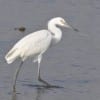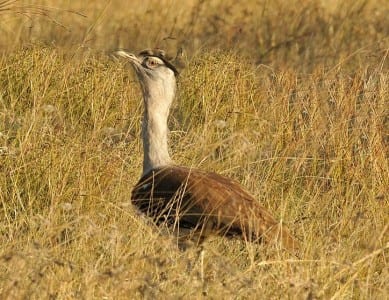 by Jim Stevenson
by Jim Stevenson
I will be leaving tomorrow for Tallahassee to deal with my mother’s estate and sell my books for the final week before Christmas at Books-a-Million in North Tallahassee. Then I will be heading for the GOS Florida Trip that will commence 7-17 January. I’ll be home in time for the Valley Trip 24-27 January before leaving immediately afterwards for the Costa Rica and Venezuela Tours. Can March come soon enough? 😉
Today’s article is on water birds, and I hope you enjoy it!

This is one of the largest flying birds on Earth, by weight, the Australian Bustard. They are absolutely huge! They fly pretty well and that’s a great way to escape the Dingos! These live out in the Outback and their plumage camouflages them perfectly. Bustards are mostly African and Australian, a result of developing in Gondwanaland.

Coots are rails, like gallinules and moorhens, but are more plump and conspicuous than traditional rails. Our American Coot is abundant in winter, and even hunted as a game bird. I am told there is a recipe for coots, with their gamey meat: Cook them in vegetables, throw away the coot and eat the veggies. 😉 Anhingas are one of four species of darters around the World, and are also called water turkey or snakebird (due to swimming with just their head and neck out of the water). Note the straight, pointed beak, separating them from cormorants. Their tail, with its brown tip, brings to mind a turkey, and the brown neck indicates a female.


Kingfishers are related to kookaburras of the Old World, and their many species also are found in several Eastern Hemisphere continents. This is a male, as he lacks the reddish banding on the chest. These Belted Kingfishers are all over the Continent but there are two other tropical species in the Rio Grande Valley.

Shorebirds have the ability to swim and exercise this occasionally. This is a winter plumage Black-bellied Plover, one of our three abundant shorebirds on our beaches fall through spring. Note the large, rounded head and short bill of a plover. These and Golden Plovers are real long-distance migrants, with many heading from the Arctic to Southern South America in fall.

Whistling-ducks are tropical species, now spreading in North America as the earth gradually warms. This Black-bellied is far more colorful than the Fulvous that prefers Louisiana, due to liking marshes rather than swamps with trees. There are other whistling-ducks in South America, as well as the Old World.

Black-bellied Whistling-ducks breed in swamps and are cavity nesters, often appreciating the carpenter work of Pileated Woodpecker. Their broods are still out on the prowl well into the Fall, as these were probably hatched around Labor Day. Whistling-ducks do not quack (like a duck?) but rather squeal when alarmed.

We have two species of cormorants in Texas, with one smaller and more slender. The Neotropic on the left (an adult, so it’s black) ranges all the way to southern South America, while the Double-crested (light due to young age) is found over most of North America. The left bird is getting into breeding plumage, as they breed in our winter.

These are adult and immature Neotropic Cormorants but the adult in the foreground isn’t yet showing any breeding plumage. Note the angled aspect of the yellow skin on the pouch, plus the relative thin look of the bird. Of course, cormorants have hooked bills while Anhingas have pointed beaks.

Curlews and godwits are somewhat similar birds, with the chief visual difference being the direction the bill curves. Godwits (this is aMarbled) probe for worms and such with their recurved (curved up) bill. Curlews (this is a Long-billed) will probe, but normally pick up small creatures like fiddler crabs off the substrate.

Great Blue Herons have a varied diet that might surprise you. In addition to fish, they will take frogs and toads, snakes, eels, rats and even smaller birds. This is a fine adult, with nice color and elegant plumes. Great Blues don’t nest with other waders, as they are not trusted by parents of other species, and rightfully so. (Having neighbors who eat your children creates disharmony).

Killdeer are plovers that live away from the water as much as around it. They are named for their loud, warning whistle and are occasionally seen feigning (pretending to be crippled). Some nest in the Deep South but numbers are augmented in winter with the arrival of more northern birds. Hunters hate these guys coz they occasionally give the men away when they are approaching ducks.

One of the most variable birds is the Herring Gull, with several ages and races (plus sex difference in size) to complicate their appearance. This bird is very light for a Herring Gull, has a rounded head instead of the typical flat head, and even has a pretty small bill (probably a female). There are a lot of rare gulls which could be confused with Herring!

This is just a scene at Brazoria NWR which amused me. In the middle of some shovelers, pintail, Green-winged Teal and Long-billed Dowitchers, a pod of male Boat-tailed Grackles are displaying together, without even a gal in sight. Refuges are terribly important to our wild bird population, providing safe haven and habitat. Below are many of the same species sleeping it off after the entertainment left. Notice the Western Willet that came in to the avian beach hotel.

David Sibley told me over lunch one time that Little Blue Herons often hold their necks at a 45-degree angle, unlike other waders. Duuh, he was right! They also tend to be far more common in freshwater, as Tri-colored Herons prefer salt. The two-toned bill may remind you of Reddish Egrets but note the purplish neck and greenish legs.

Even tougher is the juvenile Little Blue, with less colorful legs and a less distinct bill. This bird is swallowing a fish but slinging out salt water first. It is interesting that they are dark with white immatures while White Ibis are white with dark young. Reddish Egrets may be dark or light their entire lives and we’re still not sure what those white Great Blue Herons are!

Tri-colored Herons are very slender birds with super long bills and white bellies. Adults (top right) have bluer necks than the immatures with more purple necks. They tend to feed very low to the water and usually victimize the smallest of minnows with their thin beaks. This is largely a bird of the Deep South, mostly in coastal areas.

Adult Roseate Spoonbills have bare heads for feeding in murky water, not wanting to stick mud in their feathers. They get their pink from the carotene in the shrimp (like flamingos) and have a spatulate bill for gathering these crustaceans. Some spoonbills in the rest of the World, such as in Africa and Australia, are white, making them look a bit weird to us Gringos.

Immature spoonbills are less pink and have feathered heads. This may have more to do with their ancestry than current function but that’s not my field. This bird is gathering grass shrimp near our golf course and seems oblivious to my little car. Photographers and birders alike, I strongly believe that the size, sound and color of vehicles have varying effects on birds and their relative tameness.

Ibis have even more varied diets than herons and egrets, and this White Ibis is trying to figure how to down the Bullfrog* he’s uncovered. Notice the webbing on the feet of the victim, generating the power stroke that usually pushes them out of danger. It is believed that bare skin on certain wader’s heads will stay clean while feathers would otherwise get caked with mud and such. *One of the most brutal scientific experiments ever conducted was performed at the University of Florida by Dr. Ben Cutlegg. He trained a Bullfrog to leap forward at his voice command, but then amputated its legs. Over and over he then commanded the Bullfrog to leap, and of course it sat still. His findings were published, and stated that when you amputate a frog’s legs, he can’t hear.

 Posted in
Posted in 
























